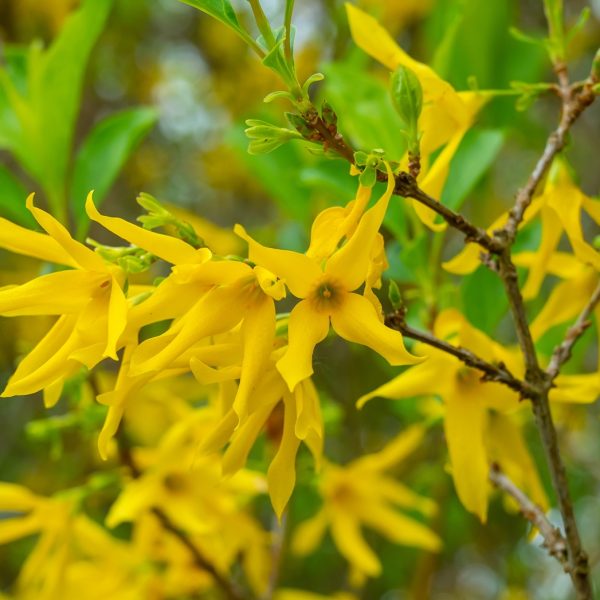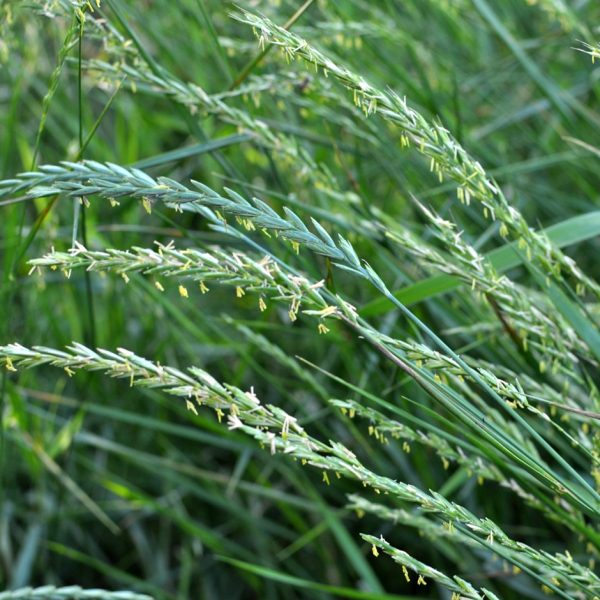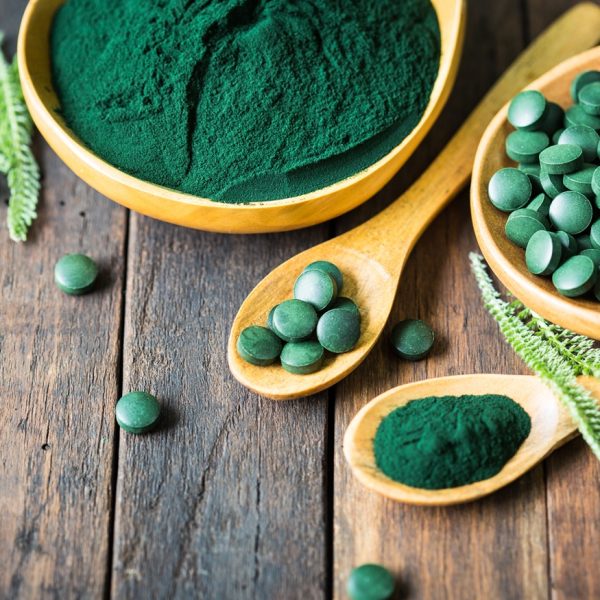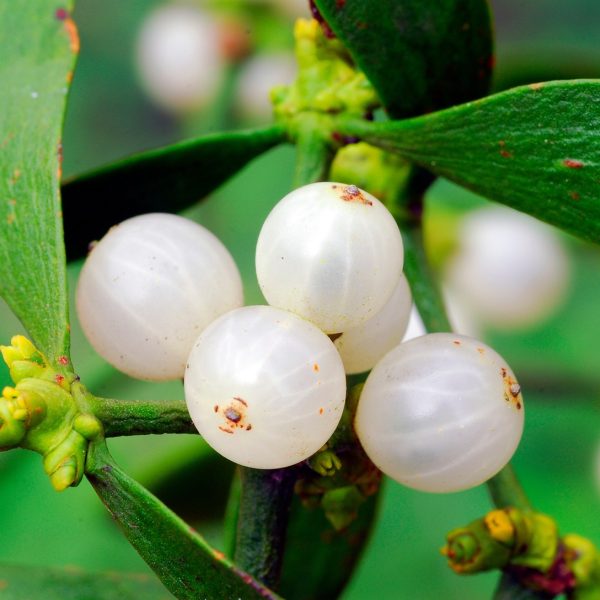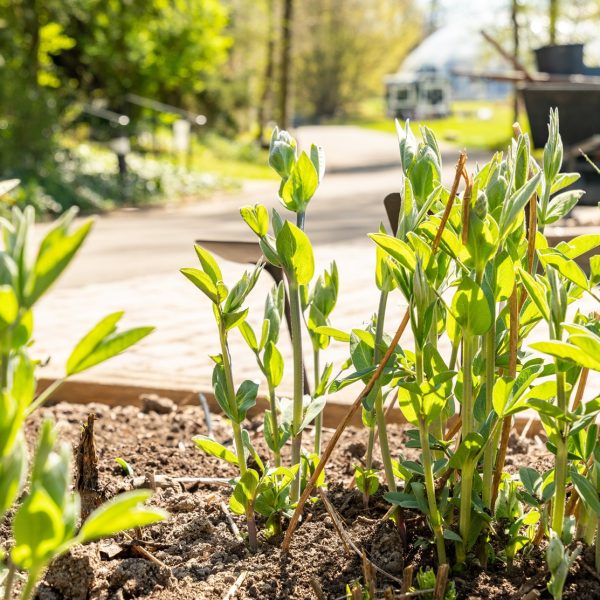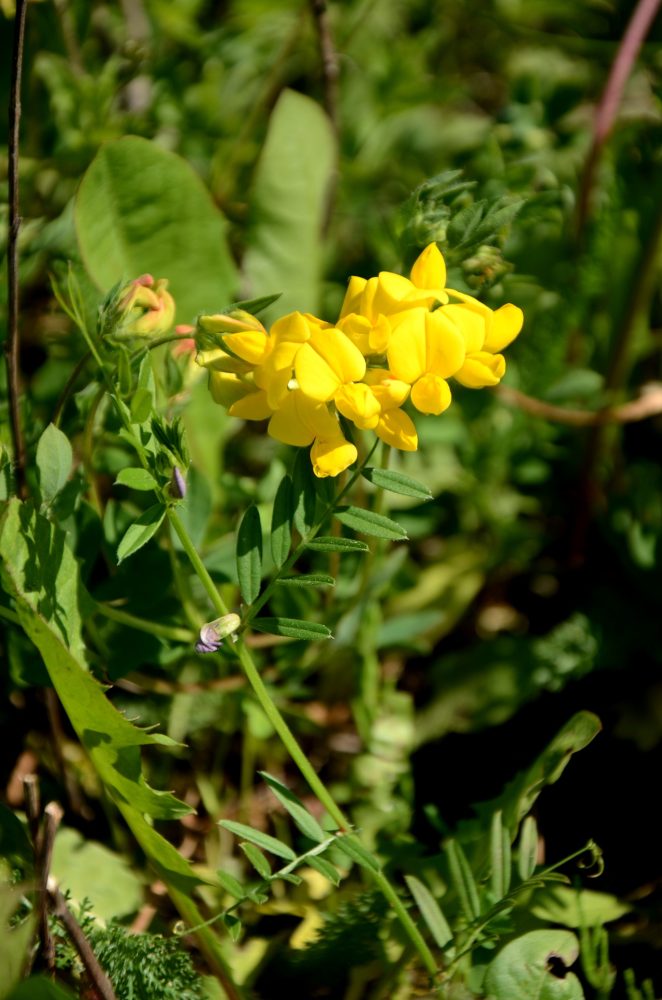-
How does it feel?
Both an infusion or a tincture of wild indigo are imbued with the rich gold colour of the flowers in bloom. The bitter pungent taste of wild indigo surprises the tongue, and is unexpected owing to the lack of any strong or distinctive aroma.
-
What can I use it for?

Wild indigo (Baptisia tinctoria) Wild indigo is considered to be specific for treating infections of the upper respiratory tract (1). Its immunomodulating, antiseptic and antiviral actions make it an effective remedy in the acute treatment of the common cold or influenza for which it is often found in preparations combined with echinacea (Echinacea purpurea/augustifolia) and white cedar (Thuja occidentalis) (1,2,3,4,5). It is considered to be most effective if taken at the initial onset of symptoms (6). Systemically, it is seen to lower a fever and relieve the symptoms of swollen and inflamed lymph glands (3,7).
It is a particularly valued herb in the treatment of infections with catarrh affecting the ear, nose and throat such as sinusitis, tonsillitis or laryngitis for which it may either be taken internally or used as a gargle or throat spray (1,7,8).
As a mouthwash, gargle or spray it has been found to relieve the discomfort of mouth ulcers and inflamed gums (3,6,7,9). For this purpose it combines well with herbs such as chamomile (Matricaria chamomilla), calendula (Calendula officinalis), myrrh (Commiphora molmol), prickly ash (Zanthoxylum clava-herculis) and sage (Salvia officinalis) (1,5,7).
Wild indigo may also be used as a topical wash for wounds, infected skin conditions or sore nipples (3,6). As a poultice, it combines well with marshmallow (Althaea officinalis) root to relieve the discomfort of spots and boils (6,8).
-
Into the heart of wild indigo

Wild indigo (Baptisia tinctoria) This cooling, drying herb is said to be indicated for the patient who presents with a swollen, blue tinged face, insufficient circulation resulting in a leaden, purplish colouration of swollen tissues (10). It is suggested to be suitable for asthenic conditions (generalised physical weakness or fatigue) where there is great fatigue accompanied by physical and mental debility (8).
Indications for the use of wild indigo as a homeopathic remedy also emphasise it as specific for asthenic conditions. The patient is described as having a besotted look to their face, being unable to think clearly, falls asleep whilst being spoken to, may complain of a sense of vertigo with pressure at the root of the nose and tightness in the skin of the forehead (11).
Throughout folklore, wild indigo was thought to be a plant guardian protecting its bearer from harm. It has been said that practitioners of witchcraft would keep the leaves of wild indigo about their person for protection (12). In more recent times, the flower essence of wild indigo is suggested to harmonise the third eye chakra and bring balance to the throat chakra enabling a person to clearly visualise their goals and dreams whilst communicating authentically with love. It is considered to be ruled by Venus embodying the beauty of this planet (13).
-
Traditional uses

Wild indigo (Baptisia tinctoria) The roots of wild indigo are said to have been used as a poultice for the treatment of snake bites by indigenous American populations and early European settlers alike. The distantly related Algonquian tribes of the Mohegan and Mohican peoples cultivated the plant for washing wounds (3).
Its recognition as a valuable herb during outbreaks of acute infectious diseases such as typhoid has been attributed to the early practitioners of the Eclectic Medical Movement, founded in the early 1900s and considered revolutionary at that time for their ethos of using plant-based medicines founded on the study of plants native to the Americans, which recognised the knowledge and experience of traditional native medicinal herb knowledge (14,15). It was highly recommended for its antiseptic and alterative properties by Professor John King in 1846 and was mentioned in an early 20th century Dispensatory by Dr James Thacher for use as a topical treatment for “gangrenous and other ill-conditioned sores due to debilitated conditions of the body” (14).
By the early 1900s, it had become widely accepted among American physicians as an epidemic remedy for the treatment of acute infectious diseases and for almost a decade was approved for use by the US Pharmacopeia based on its reported benefits in the treatment of typhoid fever (6,15).
Ellingwood, a medical practitioner and author of the 1919 volume, Eclectic Materia Medica; Therapeutics and Pharmacognosy, considered it to have established its importance in the treatment of typhoid conditions demonstrated through many years of widespread practice (7). He states the specific indications that bring to mind the need for wild indigo are “a dusky purplish colour of the face and tongue, like one exposed to the cold; the face expressionless” (16). Further indications suggested for the appropriateness of choosing wild indigo as a remedy are if a person has “stools resembling prune juice or fetid meat washings” (17).
-
Traditional actions
Herbal actions describe therapeutic changes that occur in the body in response to taking a herb. These actions are used to express how a herb physiologically influences cells, tissues, organs or systems. Clinical observations are traditionally what have defined these actions: an increase in urine output, diuretic; improved wound healing, vulnerary; or a reduction in fever, antipyretic. These descriptors too have become a means to group herbs by their effects on the body — herbs with a nervine action have become the nervines, herbs with a bitter action are the bitters. Recognising herbs as members of these groups provides a preliminary familiarity with their mechanisms from which to then develop an understanding of their affinities and nuance and discern their clinical significance.
-
Traditional energetic actions
Herbal energetics are the descriptions Herbalists have given to plants, mushrooms, lichens, foods, and some minerals based on the direct experience of how they taste, feel, and work in the body. All traditional health systems use these principles to explain how the environment we live in and absorb, impacts our health. Find out more about traditional energetic actions in our article “An introduction to herbal energetics“.
Western energetics
-
What practitioners say
 Immune system
Immune systemThe combination of potent antimicrobial and immunomodulating properties of wild indigo make it an ideal herb to include in formulas intended for the treatment of both acute and chronic infections (6,18). Seen to be most effective when taken at the very onset of acute symptoms of conditions such as the common cold or influenza, the arabinogalactan-protein constituents enhance the body’s own immune response stimulating phagocytosis whilst, it has been suggested, the polyphenolic compound genistein prevents viral replication by inhibiting tyrosine kinase. These actions may also contribute to the effectiveness of wild indigo in treating other viral infections such as herpes (HSV-1, HSV-2) and Epstein-Barr virus (EBV) (6,19).
It is also useful in acute conditions in which swollen, enlarged and painful lymph glands are a feature and when excessive fever is present (1,6,7).
It may also be of benefit alongside other herbs in recovery from low-level infections that have impacted immune function or in cases of chronic viral or fungal infection and has been suggested to have a role in the treatment of conditions in which chronic fatigue is a significant presenting symptom (6,18). It may be used in the case of post-immunisation reactions and has been specifically indicated for use following typhoid vaccinations (6,8).
Respiratory system
Wild indigo is considered by many practitioners to be specific for infections of the upper respiratory tract, such as sinusitis, pharyngitis, laryngitis, tonsillitis, catarrhal conditions or earache and is often used in combination formulas with echinacea and other herbs such as thyme (Thymus vulgaris), elderflower (Sambucus nigra), goldenrod (Solidago virgaurea), mullein (Verbascum thapsus) or ground ivy (Glechoma hederacea) (1,7,18). It is said to be especially indicated in middle ear infections (otitis media) when there is “fetid discharge from the middle ear” and in sinusitis or rhinitis in cases that present with “smell from nose or mouth and swollen glands” (20).
As a mouthwash with echinacea and myrrh (Commiphora molmo), it can help ease mouth ulcers and symptoms of periodontal disease such as inflamed, bleeding or infected gums (1,7). In the lower respiratory system, it may be included in the treatment of chronic bronchitis (6).
 Integumentary system
Integumentary systemThe lymphatic and antimicrobial actions of wild indigo make it a useful ally as an internal remedy and external preparation for the treatment of many infectious skin conditions including those caused by Staphylococcus bacteria (1,6).
Reproductive system
A decoction of wild indigo root to be used as a douche may be included in the treatment of conditions affecting the female reproductive organs such as vaginitis, cervicitis, vaginal discharge or vaginal microbiome dysbiosis resulting in vulvovaginal candidiasis (1,6).
Urinary system
Wild indigo may also have a role in the treatment of chronic cystitis along with other urinary antiseptic herbs; such bearberry (Arctostaphylos uva-ursi), or buchu (Agathosma betulina) and demulcent herbs to soothe the bladder and urinary tracts including cornsilk (Zea mays) and marshmallow (Althaea officinalis) (1,6,7).
-
Research

Wild indigo (Baptisia tinctoria) Immunomodulatory effects of arabinogalactan-proteins from baptisia and echinacea
This in vitro study from 2006 explores the previously little understood mechanism of action of wild indigo on immunological activity. Investigations were focused on the actions of specific arabinogalactan-proteins (AGPs) on lymphocyte proliferation and IgM production alongside macrophage nitrite and IL6 production comparing it with similar constituents derived from two species of echinacea which previous pharmacological investigation has shown to demonstrate immunomodulatory activities that differ from those of wild indigo. In contrast to the high activity in all areas tested from extracts containing AGPs from both wild indigo and E. pallida, the AGPs from E. purpurea demonstrated no influence on any of the test systems.
There is evidence to suggest that the mechanism of action of the AGPs in relation to the immunomodulatory effects of wild indigo may be mediated through activation of the Peyer’s patches, gut-associated lymphoid tissue (GALT) in the small intestine which plays a key role in immune function. Furthermore, the AGPs have been demonstrated to interact with the complement system, an integral part of the innate immune response (21).
A randomised, double-blind, placebo-controlled, clinical dose–response trial of an extract of baptisia, echinacea and thuja for the treatment of patients with common cold
Research or clinical trials of wild indigo as a single study subject are under-represented when compared to studies that include it combined with other plant extracts. The aim of this randomised, double-blind, placebo-controlled clinical trial in 2005 was to verify the efficacy and safety of a herbal medicine combining extracts of wild indigo, echinacea and thuja to treat upper respiratory tract infections.
This study compared the onset of improvement and time until marked improvement between the individuals receiving the active product (n=31, 19.2 mg dose; n=29, 9.6 mg dose) and those taking a placebo (n=31) three times daily over a treatment period of 3–12 days, dependent upon individual symptom duration. Results showed that the patients who took the wild indigo, echinacea and thuja extract (see paper for preparation details) were seen to recover faster than the control group.
This effect was observed to be dose-dependent, with the greatest efficacy seen at the highest doses with no safety concerns or adverse effects at any dosage. From these results, it was concluded treatment with this combined herbal preparation is most effective if commenced at a high dose during the early onset of any upper respiratory tract infection (22).
Efficacy and safety of a fixed combination phytomedicine in the treatment of the common cold (acute viral respiratory tract infection): Results of a randomised, double blind, placebo controlled, multicentre study
Similar outcomes were reported in this earlier clinical trial from 1999 which aimed to assess the efficacy of a similar combination of wild indigo, echinacea and thuja herbal preparation in the treatment of the common cold. Each tablet contained 10 mg Baptisia tinctoria dried root, 7.5 mg Echinacea purpurea (dry root), 2 mg Thuja occidentalis (dry leafy twig).
The primary objective of the study was to validate the value of the preparation in promoting rapid resolution of acute symptoms. Each treatment group took three tablets (active or placebo), three times daily for up to 10 days until symptoms subsided. This was measured through parameters including severity of throat and nasal symptoms, presence of fever, pain experienced, overall severity and sense of wellbeing scores and the need for treatment.
Results of this clinical trial indicated that by day three of treatment, close to 20% of patients receiving the herbal preparation (n=132) were showing a response compared with zero patients from the placebo group (n=131) (23).
Efficacy of Baptisia tinctoria in the treatment of typhoid: Its possible role in inducing antibody formation
Wild indigo as a whole herb preparation has been established for the treatment of typhoid since the early 1900s and, more recently, indicated for use following typhoid inoculations (8).
This non-randomised clinical study involving 119 participants investigates the efficacy of wild indigo in an ultra dilute dosage level in the form of homeopathic preparations administered over 10 days, particularly for the prevention of typhoid. The mode of action was suggested to be the activation of immune system T and B cells creating an endogenous antibody effective against the Salmonella typhi (typhoid) bacterium (24).
-
Did you know?
A less commonly used name for wild indigo is rattleweed, derived from the sound of the seeds rattling around inside the inflated black ripe seed pods which were used as toys by the small children of some indigenous American peoples (12,25). Another less frequently used common name for wild indigo is horsefly weed, gained from its tradition of being fastened to the harnesses of horses to protect them from being irritated by horseflies (26).
According to the Doctrine of Signatures; a theory dating back to antiquity that postulates that the characteristics of a plant such as shape, growing conditions, colour or patterning are an indication of conditions or symptoms that plant will treat, the black colouration of the leaves and seed pots of wild indigo when injured or ripe suggest its benefits for conditions such as gangrene, necrosis and putrid deterioration (27).
Its scientific name, or Latin binomial, Baptisia tinctoria refers to its use historically as a source of dye, albeit generally considered inferior to the plant that is the source of true indigo dye, Indigofera tinctoria, although they do both belong in the Fabaceae family. The etymological root of the genus name Baptisia comes from the Greek word baptos which translates as ‘to dye’. The use of tinctoria in a plant name indicates that the plant has historically been used as a source of dye (17,28,29).
Additional information
-
Botanical description
Wild indigo is a deciduous herbaceous perennial bushy shrub with a round smooth branching stem typically growing to a full height of between 90–150 cm. It has woody black roots which penetrate deeply into the ground, however, are somewhat delicate and prone to damage if disturbed (28,36,37).
The small dark grey-green leaves are palmate with three wedge-shaped leaflets that radiate out from the centre point appearing alternately down the stem (26,28,38). Its numerous bright yellow flowers grow in long terminal clusters that bloom from May through to September depending on the region, and have the typical appearance of Fabaceae family plants (26,28,29). Wild indigo is hermaphrodite bearing both staminate and pistillate reproductive organs on the same plant and is pollinated in the springtime by bees (39,40).
Once flowering is complete, ellipsoid shaped inflated seed pods of about 2 cm in length develop which turn black as they ripen between August and October, enclosing within them the small brown kidney shaped seeds that are released when the pod reaches maturity and splits along the line of its ridge.
Once fully mature, the plant itself turns a grey-silver colour and detaches at ground level from its root system allowing it to be tumbled around by the wind to new locations ensuring wide distribution of its seeds (26,40).
-
Common names
- Wild indigo
- Yellow false indigo
- Yellow broom
- Horsefly weed
- Rattle-weed
-
Safety
Wild indigo is not recommended whilst pregnant or breastfeeding as there is insufficient evidence to establish its safety during these times (2,6,30,31),
Although overall it is considered to be a relatively safe herb, the phytoestrogenic constituents it contains such as genistein, should be taken into consideration when treating some oestrogen related conditions as it can act as an oestrogen agonist or antagonist (2,9).
Prolonged use or large doses are not advised and may result in vomiting or laxative effects (3,6,10,32).
-
Interactions
No known interactions reported (1,7,30,32)
-
Contraindications
- Not to be taken during pregnancy or breastfeeding (2,6,30,31)
- Caution for use by people who have stomach or intestinal issues (14,31)
-
Dosage
- Tincture (1:5 | 60%): Typical weekly dosage is between 15–40 ml (1). An average daily dose would be 1 ml to be taken three times a day (7,33).
- Fluid extract: 1:1 | 60%): 0.3–1.3 ml 3 times daily (16).
- Decoction: ½ to 1 teaspoon of root to be added to one cup of water, bring to boil and simmer for ten minutes to be drunk three times a day (7). As a decoction it may also be used as a mouthwash or gargle, as a topical wash or as a douche (3,6).
- Poultice: Wild indigo may also be used topically in the form of a poultice for spots, boils and infected wounds (6).
-
Plant parts used
- Root
- Leaf
-
Constituents
- Polysaccharides: Mainly arabinogalactan-proteins (APGs), considered to be responsible for the immune modulating properties of this plant, including baptisin and baptin (1,2,34,35)
- Phenolic compounds: Isoflavones including baptigenin, pseudobaptigenin, formononetin, and genistein; coumarins including scopoletin (2)
- Alkaloids: Sparteine, cytisine (previous known as baptitoxin), cytosine (1,2,6)

-
Habitat
The native range of wild indigo extends from southeastern Canada to central and south-eastern North American, primarily growing in the temperate zone (28,40,41). Thriving best in full sun, and having a preference for dry, sandy, barren soils; it is commonly found growing in meadows, along roadsides, in open woodlands and clearings or in soil that has been burnt (28,39,41).
-
Sustainability

Not currently on risk lists but complete data may be missing on the status of the species. Read more in our sustainability guide. Wild indigo has not yet been evaluated for its sustainability status by the IUCN Red List; however, it is not considered to be at risk of extinction (40,41,42). Despite this, in some areas of its native range throughout the eastern regions of the US, it has been found to be rare and is protected by the state authority. It is listed as threatened in Kentucky and considered endangered in Maine (25,26).
The impact of wild harvesting of wild indigo on other species also should be considered as a priority with regard to ethical and sustainable choices for sourcing of medicinal plants. Wild indigo provides, in some cases one of the only, sources of food for a diversity of species of butterfly and moth caterpillars (40).
Habitat loss and over-harvesting from the wild are two of the biggest threats faced by medicinal plant species. There are an increasing number of well-known herbal medicines at risk of extinction. We must, therefore, ensure that we source our medicines with sustainability in mind.
The herb supplement industry is growing at a rapid rate and until recent years a vast majority of medicinal plant produce in global trade was of unknown origin. There are some very real and urgent issues surrounding sustainability in the herb industry. These include environmental factors that affect the medicinal viability of herbs, the safety of the habitats that they are taken from, as well as the welfare of workers in the trade.
The botanical supply chain efforts for improved visibility (transparency and traceability) into verifiably sustainable production sites around the world is now certificated through the emergence of credible international voluntary sustainability standards (VSS).
Read our article on Herbal quality & safety: What to know before you buy and Sustainable sourcing of herbs to learn more about what to look for and questions to ask suppliers about sustainability.
-
Quality control
Herbal medicines are often very safe to take; however, their safety and efficacy can be jeopardised by quality issues. So, it is important to buy herbal medicines from a reputable supplier, from sources known to test their herbs to ensure there is no contamination, adulteration or substitution with incorrect plant matter, as well as ensuring that recognised marker compounds are at appropriate levels in the herbs.
Some important quality assurances to look for are certified organic labelling, the correct scientific/botanical name, and the availability of information from the supplier about ingredient origins. A supplier should be able to tell you where the herbs have come from, what contaminants are not in the herb, and what the primary compounds are.
-
How to grow

Wild indigo (Baptisia tinctoria) Wild indigo are hardy plants that will tolerate a range of conditions including barren, dry environments, soil erosion and drought against which its deep roots make it particularly resilient, however this does result in wild indigo being difficult to transplant once it has become established (37,38). They can easily be propagated from seed or stem cuttings and should be transplanted to a sunny position in a border or open meadow (37).
Wild indigo has evolved to survive in environments prone to fires so the above-ground parts have adapted to this and are very resilient to disturbance, unlike the deep fragile roots which are easily disturbed so transplantation needs to involve carefully digging widely and deeply around the plant to avoid breaking the roots as far as possible (37).
They will grow in soils ranging from light sandy to medium loamy preferring a mildly acidic or neutral pH level. Wild indigo thrives in full or partial sun and cannot grow in the shade (39).
Although wild indigo requires no feeding or fertiliser, it is a nitrogen fixing plant due to its root nodules and thus helps the local soil quality. It has no particular insect or disease threats but cannot abide ill-draining or overly rich soils and will fail to thrive in these environments (37).
The additional benefits of of introducing wild indigo to any landscape includes increased species biodiversity, as it is a host plant for many species of butterflies and moths whilst other insects and spiders eat the seeds and shelter in the pods, soil enrichment and ground stabilisation through it’s nitrogen fixing properties and deep root structure (12,37).
-
References
- Thomsen M. The Phytotherapy Desk Reference. 6th ed. Aeon Books; 2022.
- Edwards SE, Da Costa Rocha I, Williamson EM, Heinrich M. Phytopharmacy: An Evidence-Based Guide to Herbal Medicinal Products. John Wiley & Sons; 2015.
- Chevallier A. Encyclopedia of Herbal Medicine. Dorling Kindersley; 2000.
- Trickey R. Women, Hormones and the Menstrual Cycle. 4th ed. Elsevier; 2024.
- Hobbs C. Wild Indigo – Dr. Christopher Hobbs, PhD. Christopher Hobbs. https://christopherhobbs.com/herbal-therapeutics-database/herb/wild-indigo/. Accessed June 2, 2025.
- McIntyre A. The Complete Herbal Tutor: The Definitive Guide to the Principles and Practices of Herbal Medicine. 2nd ed. Aeon Books; 2019.
- Hoffmann D. Medical Herbalism: The Science and Practice of Herbal Medicine. Healing Arts Press; 2003.
- Priest AW, Priest LR. Herbal Medication: A Clinical and Dispensary Handbook. Foulsham; 1983.
- Wren RC, Williamson EM, Evans FJ. Potter’s New Cyclopaedia of Botanical Drugs and Preparations. C.W. Daniel Company Ltd; 1988.
- Easley T, Horne S. The Modern Herbal Dispensatory: A Medicine-Making Guide. North Atlantic Books; 2016.
- Boericke W. Homeopathic Materia Medica. http://www.homeoint.org/books/boericmm/b/bapt.htm. Accessed June 2, 2025.
- Rankel K. Symbolism and Benefits of the False Indigo. Greg.app. Published March 5, 2024. https://greg.app/false-indigo-benefits/#:~:text=False%20Indigo’s%20narrative%20weaves%20through,rattle%20of%20its%20dried%20pods. Accessed June 2, 2025.
- Whispering Roots Apothecary. Blue Wild Indigo Flower Essence. Whispering Roots Apothecary. https://www.whisperingrootsapothecary.com/products/wild-blue-indigo-flower-essence. Accessed June 2, 2025.
- Baptisia,—Wild Indigo. Henriette’s Herbal Homepage. https://www.henriettes-herb.com/eclectic/potter-comp/baptisia.html. Accessed June 2, 2025.
- Exploring the Eclectics and the Eclectic Medical Movement. Eclecticherb. Published September 9, 2024. https://eclecticherb.com/blogs/news/exploring-the-eclectics-and-the-eclectic-medical-movement?srsltid=AfmBOop-OpFfGSGZphYrhKaNDVyXTUSvOfcnoebaNU_qm3qU-DJTXuvY. Accessed June 2, 2025.
- Bartram T. Encyclopedia of Herbal Medicine. Grace Publishers; 1995.
- Cote J. Baptisia tinctoria. Northeast School of Botanical Medicine. Published November 18, 2018. https://7song.com/baptisia-tinctoria/. Accessed June 2, 2025.
- Bone K, Mills S. Principles and Practice of Phytotherapy: Modern Herbal Medicine. 2nd ed. Elsevier Health Sciences; 2013.
- Coffman S. Herbal Medic: A Green Beret’s Guide to Emergency Medical Preparedness and Natural First Aid. Hachette UK; 2021.
- Wood M. The Earthwise Herbal Repertory: The Definitive Practitioner’s Guide. North Atlantic Books; 2016.
- Classen B, Thude S, Blaschek W, Wack M, Bodinet C. Immunomodulatory effects of arabinogalactan-proteins from Baptisia and Echinacea. Phytomedicine. 2005;13(9-10):688-694. https://doi.org/10.1016/j.phymed.2005.10.004
- Naser B, Lund B, Zepelin HH, Köhler G, Lehmacher W, Scaglione F. A randomized, double-blind, placebo-controlled, clinical dose–response trial of an extract of Baptisia, Echinacea and Thuja for the treatment of patients with common cold. Phytomedicine. 2005;12(10):715-722. https://doi.org/10.1016/j.phymed.2005.03.002
- Zepelin HHHV, Hentschel C, Schnitker J, Kohner R, Kohler G, Wustenburg P. Efficacy and safety of a fixed combination phytomedicine in the treatment of the common cold (acute viral respiratory tract infection): results of a randomised, double blind, placebo controlled, multicentre study. Curr Med Res Opin. 1999;15(3):214-227. https://doi.org/10.1185/03007999909114094
- Banerji P, Banerji P, Das GC, et al. Efficacy of Baptisia tinctoria in the treatment of typhoid: its possible role in inducing antibody formation. J Complement Integr Med. 2012;9(1). https://doi.org/10.1515/1553-3840.1622
- USDA NRCS National Plant Materials Center, Novak J. Plant Fact Sheet: Baptisia tinctoria. USDA. https://plants.usda.gov/DocumentLibrary/factsheet/pdf/fs_bati.pdf. Accessed June 2, 2025.
- USDA Plants Database. Baptisia tinctoria. USDA. https://plants.usda.gov/plant-profile/BATI. Accessed June 2, 2025.
- Wood M. The Book of Herbal Wisdom: Using Plants as Medicines. North Atlantic Books; 1997.
- Phillips R, Foy N. Herbs. Pan Books; 1992.
- Baptisia tinctoria – Plant Finder. Missouri Botanical Garden. https://www.missouribotanicalgarden.org/plantfinder/PlantFinderDetails.aspx?taxonid=280647. Accessed June 2, 2025.
- NatMed Pro. Therapeutic Research Center. https://naturalmedicines.therapeuticresearch.com/#. Accessed June 2, 2025.
- Wild indigo: health benefits, side effects, uses, dose & precautions. RxList. Published June 11, 2021. https://www.rxlist.com/supplements/wild_indigo.htm#. Accessed June 2, 2025.
- Brinker FJ. Herb Contraindications and Drug Interactions: With Appendices Addressing Specific Conditions and Medicines. Eclectic Medical Publications; 1998.
- Buhner SH. Herbal Antibiotics, 2nd Edition: Natural Alternatives for Treating Drug-resistant Bacteria. Storey Publishing, LLC; 2012.
- Ganora L. Herbal Constituents: Foundations of Phytochemistry. Herbalchem Press; 2009.
- Wack M, Classen B, Blaschek W. An acidic arabinogalactan-protein from the roots of Baptisia tinctoria. Planta Med. 2005;71(9):814-818. https://doi.org/10.1055/s-2005-871247
- Baptisia tinctoria | wild indigo Herbaceous Perennial. Royal Horticultural Society. https://www.rhs.org.uk/plants/41218/baptisia-tinctoria/details. Accessed June 2, 2025.
- New England Wild Flower Society. Baptisia tinctoria. Native Plant Trust. https://plantfinder.nativeplanttrust.org/plant/Baptisia-tinctoria. Accessed June 2, 2025.
- Baptisia (Baptisia, false indigo, wild indigo). North Carolina Extension Gardener Plant Toolbox. https://plants.ces.ncsu.edu/plants/baptisia/. Accessed June 2, 2025.
- Baptisia tinctoria Wild Indigo, Horseflyweed. Plants For A Future. https://pfaf.org/user/Plant.aspx?LatinName=Baptisia+tinctoria. Accessed June 2, 2025.
- United Plant Savers. Wild Indigo – Baptisia tinctoria. United Plant Savers. Published February 5, 2025. https://unitedplantsavers.org/wild-indigo-baptisia-tinctoria/#:~:text=Baptisia%20tinctoria%20has%20not%20yet%20been%20evaluated%20by%20the%20IUCN%20Red%20List. Accessed June 2, 2025.
- Baptisia tinctoria (L.) R.Br. Plants of the World Online. Kew Science. https://powo.science.kew.org/taxon/urn:lsid:ipni.org:names:1198899-2. Accessed June 2, 2025.
- American Botanical Council. HerbalGram: Baptisia tinctoria. https://www.herbalgram.org/search?search=baptisia%20tinctoria. Accessed June 2, 2025.

